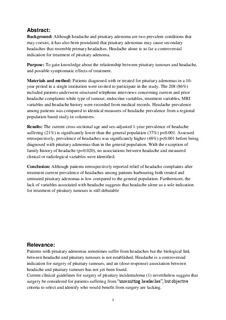Pituitary adenoma and headache
Abstract
Background: Although headache and pituitary adenoma are two prevalent conditions that
may coexist, it has also been postulated that pituitary adenomas may cause secondary
headaches that resemble primary headaches. Headache alone is so far a controversial
indication for treatment of pituitary adenoma.
Purpose: To gain knowledge about the relationship between pituitary tumours and headache,
and possible symptomatic effects of treatment.
Materials and method: Patients diagnosed with or treated for pituitary adenomas in a 10-year period in a single institution were invited to participate in the study. The 208 (86%)
included patients underwent structured telephone interviews concerning current and prior
headache complaints while type of tumour, endocrine variables, treatment variables, MRI
variables and headache history were recorded from medical records. Headache prevalence
among patients was compared to identical measures of headache prevalence from a regional
population based study in volunteers.
Results: The current cross sectional age and sex-adjusted 1-year prevalence of headache
suffering (21%) is significantly lower than the general population (37%) p<0.001. Assessed
retrospectively, prevalence of headaches was significantly higher (48%) p<0.001 before being
diagnosed with pituitary adenomas than in the general population. With the exception of
family history of headache (p=0.020), no associations between headache and measured
clinical or radiological variables were identified.
Conclusion: Although patients retrospectively reported relief of headache complaints after
treatment current prevalence of headaches among patients harbouring both treated and
untreated pituitary adenomas is low compared to the general population. Furthermore, the
lack of variables associated with headache suggests that headache alone as a sole indication
for treatment of pituitary tumours is still debatable
